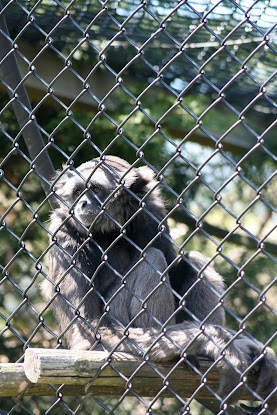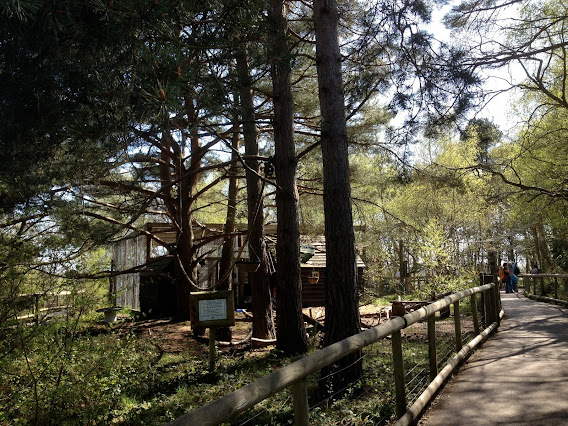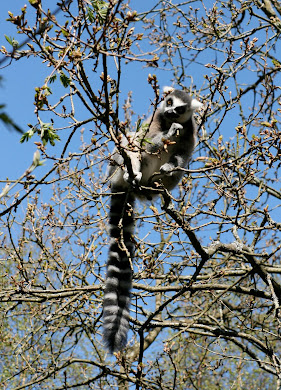I want to preface this post by saying that it’s been one of the harder ones to decide whether to write. On the one hand, it feels a little unprofessional and self-sabotaging to criticise a conference at which one was an invited speaker. On the other hand, my recent experience of an OMICS Group conference was so poor that I feel compelled to warn others. One thing I want to make clear from the outset, however, is that I do not want to denigrate any of the speakers; despite the shortcomings of the conference itself, there was nothing wrong with the contributions of those in attendance. (I wish I could say the same of the OMICS Group organisers.)
 Earlier this year, I was invited to speak at the OMICS Group 3rd International Conference of Proteomics and Bioinformatics, held in Philadelphia earlier this month. It sounded like it would be a fairly big conference - the topic was broad, the website listed 24 conference organisers (including scientists from renowned Universities), eleven thematic tracks and venue pictures featuring a conference room of reasonable size set up for a talk. Although I am not generally a fan of massive conferences, it is good to present at one; I recognised a couple of names of confirmed presenters, one of whom was a friend, and after weighing up the costs I decided to accept the invitation. With hindsight, I was rather naïve and/or gullible in accepting the invite. The conference website, it seems, is very misleading - it lists four front-page “Renowned speakers”, for example, of whom only two actually spoke at the conference. At the time, though, I had no particular reason to be wary.
Earlier this year, I was invited to speak at the OMICS Group 3rd International Conference of Proteomics and Bioinformatics, held in Philadelphia earlier this month. It sounded like it would be a fairly big conference - the topic was broad, the website listed 24 conference organisers (including scientists from renowned Universities), eleven thematic tracks and venue pictures featuring a conference room of reasonable size set up for a talk. Although I am not generally a fan of massive conferences, it is good to present at one; I recognised a couple of names of confirmed presenters, one of whom was a friend, and after weighing up the costs I decided to accept the invitation. With hindsight, I was rather naïve and/or gullible in accepting the invite. The conference website, it seems, is very misleading - it lists four front-page “Renowned speakers”, for example, of whom only two actually spoke at the conference. At the time, though, I had no particular reason to be wary.
There were a few bad signs before even turning up to the conference, included poor information regarding the speaker guidelines and even the hotel in which the conference was taking place. The big one that worried me most was the timetabling of the conference when the full scientific programme was finally released. Despite 11 “tracks”, the conference was organised into a single stream. This is not so bad in itself - parallel sessions often cause problems of clashing talks of interest; the issue was that the resulting programme was so crammed full, there were hardly any breaks.
As anyone who has been to conferences knows, many of the most productive parts of the conference are the conversations over coffee, lunch and evening refreshments. This conference had scheduled two 15 minute coffee breaks and 40 minutes for lunch in the context of days of 9-6 talks. A one hour “cocktail” (beer and wine) session was listed for each day but there was no conference dinner or other activity to promote extended interaction. Not only was I worried about the lack of interactions - particularly for someone a bit introverted like me who is a bit slow to warm up - from past experience, there was a chance that talks would over-run to the point that breaks would disappear and/or it would take longer than the coffee break to get everyone out of the auditorium and lined up for coffee.
(As it happens, concerns about breaks were ill-founded. The reason for this is that the disorganisation of the conference at the event and the alarming no-show rate of speakers meant that we often ended up with extra time for breaks. The exception to this was Day 1 but I’m getting ahead of myself and will come back to that.)
Despite these warning signs, I really wasn’t ready for the shambles that was to come. Having had breakfast on Monday in the wrong room due to lack of information, I went to the conference suite to register and make my way to the conference room. The conference pack itself set the scene for the conference, being mostly advetising for OMICS Group activities with precious little regard for the science. (No lists of attendees, or places to write notes that I could see.) This was then reflected in the venue.
 For one thing, it was tiny. I mean tiny. The venue image that I previously interpreted as the one of several parallel sessions turned out to be twice the size of the venue for the entire conference. This is partly because the room had been divided and the other half was being used for another OMICS conference. (There were three in the hotel plus one or two other meetings not organised by the OMICS Group.)
For one thing, it was tiny. I mean tiny. The venue image that I previously interpreted as the one of several parallel sessions turned out to be twice the size of the venue for the entire conference. This is partly because the room had been divided and the other half was being used for another OMICS conference. (There were three in the hotel plus one or two other meetings not organised by the OMICS Group.)
Not only was it tiny but the layout was awful - half a dozen large round tables surrounded by ten or so chairs each. Given that there were 52 speakers on the programme plus four keynote speakers and one workshop presenter, this was not encouraging. A conference with 24 listed of conference organisers having not much more than double that number of participants tells you that there is a problem somewhere. The biggest thing in the room was the banner advertising the OMICS Group and its sponsors.

Things did not get any better once the conference began. The schedule included a rather intriguing 30 minute(!) slot for an "opening ceremony", which again added to the pre-conference illusion of grandeur. In reality, it was five minute introduction by an unfortunate member of the keynote forum who seemed to have been volunteered for the role not long before. Furthermore, the absence of formal organisation was such that agreeing to this role seemed to land him with the unenviable task of essentially organising and managing the rest of the speaker lineup for the rest of the conference. To add insult to injury, this was someone who was not even on the organising committee.
The rest of the day was odd, bordering on farce. Things started OK. Thanks to the “opening ceremony”, we were running ahead of schedule. One of the keynote speakers had substituted a junior member of their lab in their place - a good move, I now see - but the keynotes were generally interesting and I was beginning to think “maybe this won’t be so bad”. At that point, the conference organisers made their only detectable organisational intervention - the group photo.
Quite why you want a photo showing how embarrassingly tiny your broad International conference is, I don’t know, but they did - enough to not only obliterate our time cushion but (thanks to some comically bad preparation and organisation by the photographer) also eat into the scientific schedule. This for me summed up the whole endeavour: science taking second place to OMICS Group publicity. The photo is now up on the website and reproduced below. I count 48 people. There were 57 listed speakers. (I will come back to that!) Remember, this is for a conference with an alleged 24 organisers!

I now suspect that essentially everyone at the conference had been invited to speak and that the “organising committee” had no role in the organisation or speaker lineup - indeed, I wonder if they all even know that they are being listed as organisers. Nevertheless, after a now-delayed coffee, things picked up again with some interesting talks, although there had clearly been little or no instruction (and sometimes little thought) regarding the technicalities of getting talks ready and computers switched over etc.. (There wasn’t even a clicker for advancing slides - I had to use my own!) Thanks to a few hiccups compounding the photographic nonsense earlier, we were late for our 40 minute lunch break.
Lunch. This should be one of the best times in any conference - a time to discuss the science of the morning and look at what’s on offer in the afternoon. After a couple of interesting talks, I was looking forward to a bit of discussion. Instead, lunch was a buffet affair on the mezzanine floor, shared by all the conferences and with insufficient tables and seating to be able to sit even with the two or three people you were just chatting to in the lift. On one occasion, I stood up to get a coffee after lunch and found my seat taken by members of another conference before I could return to it. Later, we were even asked to leave our table to make room for the next conference when I was still eating. (On that occasion, we were still well within the allotted lunch time on the programme.) The food itself was pretty nice but lunch, thanks to shoddy organisation, was one of the worst conference lunch experiences I have had.
The rest of the conference bumbled along in much the same vein. I’ve been at a few conferences where the schedule has been re-jigged slightly on the day but never before have I been at a conference where speakers were AWOL and nobody appeared to know. Before each talk, there was a hopeful appeal to the audience for the speaker to come forth and show themselves - or, as in a few cases, not. The first couple of times, I thought it a bit rude to just not show up but I fear that the real reason might be a bit more sinister - the OMICS Group, it seems, have a reputation for not refunding people who decide to pull-out of their activities; given the small size, I would not be surprised if they kept those that withdraw on their programme. As far as I can tell, the OMICS Group simply do not care if conference is a disaster, as long as they can spin it as a success. The packed programme quite possibly exists only to maximise the number of names they can associate with their conference for some credibility.
One of the saddest things - and one of the reasons for this post - is that a little more research on my part would have warned me off. The Scholarly Open Access blog had an article from January this year: OMICS Goes from “Predatory Publishing” to “Predatory Meetings”. (My wife emailed me the link at the meeting but I wasn’t brave enough to read it until at the airport to come home!) The title says it all really but some of the content within resonated with me quite strongly.
Now new evidence has surfaced revealing that OMICS, which is also in the business of organizing scientific conferences, has been 1) using the names of scientists, oftentimes without their permission, to invite participants to their meetings, 2) promoting their meetings by giving them names that are deceptively similar to other well-established meetings that have been held for years by scientific societies, and 3) refusing to refund registration fees, even if their meetings are cancelled.
First, OMICS implies that its editorial board members are conference organizers by placing their names and photographs on their conference web pages, and by sending email invitations to their meetings which are “signed” by members of the editorial boards. However, many of these people never agreed to be meeting organizers, and some have never even agreed to be become OMICS editorial board members.
The rest of the post - and the comments (to which I have now added) - do not make comfortable reading. The author ends by saying:
I strongly recommend, in the strongest terms possible, that all scholars from all countries avoid doing business in any way with the OMICS Group. Do not submit papers. Do not agree to serve on their editorial boards. Do not register for or attend their conferences.
I find myself having to agree. Despite the small size, lack of focus and crappy organisation, I did actually get some useful outcomes from the conference but these were despite the efforts of the organisers rather than because of them. Some of the science and individual presentations were of good quality but this was the worst scientific conference that I have attended by a long stretch - and I let them know as much in my feedback form! (Of course, visiting the conference website now shows a bunch of supportive quotes of praise, making it look like an unmitigated success. Either these individuals were at a different conference to me, have not experienced a good conference, or are way too polite.)
 The whole thing left me feeling a little violated, to be honest. The delusions of grandeur portrayed by my “Certificate of Recognition” does nothing to ease this sense:
The whole thing left me feeling a little violated, to be honest. The delusions of grandeur portrayed by my “Certificate of Recognition” does nothing to ease this sense:
OMICS Publishing Group and Editor (s) … enjoy special privilege to felicitate [me] for his/her phenomenal and worthy oral presentation…
Even worse is what happens if you click “View More” following the “Renowned Speakers” on the front page. Another page is opened listing 42 “Executive Editors”. I am dismayed to find myself listed among them. I am not sure what qualifies someone for the list - as far as I can tell, not all those listed spoke at the conference and not all of the conference speakers are listed - but I want to make it quite clear that I have made no executive and/or editorial contribution to the OMICS Group. I have contacted them about this error, so hopefully it will be rectified. (I am not holding my breath.)
I am not sure whether they are fraudsters but, either way, I also strongly advise boycotting OMICS Group activities on the basis that they are scientifically bankrupt beyond anything that individual attending scientists bring to that activity. It is possible that I was just unlucky. Given the Scholarly Open Access comments and the apparent lack of embarrassment - and total lack of apologies - at the utter shambles that was the OMICS Group 3rd International Conference of Proteomics and Bioinformatics, I highly doubt it. For this reason, I feel the need to warn others.
Conferences are not cheap, so save your money and use it to go to a conference organised by scientists, for scientists, with science and not money/prestige/publicity as the primary motivator. Based on my experience, this will not be one organised by the OMICS Group.
There is one other thing I have learnt from this experience: if you are invited to present at a conference, do your homework.
[NB. I have made the OMICS Group aware of my thoughts and concerns. I will update this page in the light of any responses.]
[Update 4/12/13: Although OMICS Group never responded to any of my emails, it appears that they have modified their conference homepage and I am no longer listed as an “Executive Editor”. Doubly so, in fact, as they have corrected the title to read “Renowned Speakers” instead and removed me from the list!]
[Update 18/8/15: ABC have a recent exposé of predatory publishers (including OMICS), which is worth a read or listen.]








































